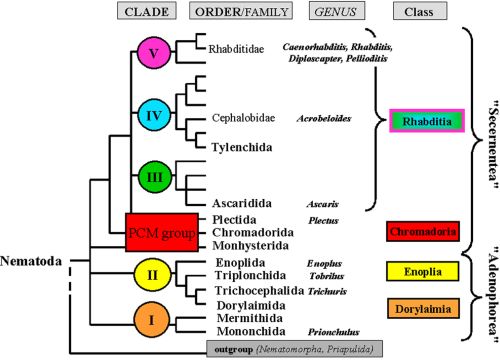Domain- Eukarya
Trichuris vulpis belongs in the kingdom eukarya because it is multicellular with the presence of membrane bound organelles.
Kingdom- Animalia (Metazoa)
T. vulpis is heterotrophic, multicellular, motile, and lack cell walls; all of these characteristics place T. vulpis with the animals.
Phylum- Nematoda
T. vulpis is an unsegmented pseudocelomate with a complete digestive tract. They are also dioecious (seperate sexes), posses a hydrostatic skeleton, and grow by molting which are all characteristic of the nematodes or roundworms.
 The phylum Nematoda gets a little tricky here, the breakdown that I am using here is based on genome sequencing of the 18s RNA gene sequence but I have also included some morphological characteristics of each level.
The phylum Nematoda gets a little tricky here, the breakdown that I am using here is based on genome sequencing of the 18s RNA gene sequence but I have also included some morphological characteristics of each level.Class- Adenophorea/ Subclass- Enoplia
It is likely that members of the Enoplia appeared first and also possibly have given rise to some of the other classes/lineage. They posses some features that are ancestral within nematodes such as an indeterminate mode of development and the presence of a nuclear envelope in spermatozoa.
Order- Trichocephalida
Members of this order are known for their stichosome esophagus which is made of of a columb of gland cells called stichocytes surrounding a capillary tube.
Family- Trichuridae
A major characteristic of this group is their parasitic tendencies in the intestines of vertebrates.
Genus- Trichuris
All of the whipworms are a member of this group and infect a number of mamalian species including humans. Their anterior end is thicker like the handle of a whip which is like the posterior end. The eggs are lemon shaped.
Species- Trichuris vulpis Froelich 1789
Known as the dog whipworm; infects the intestines of canines and rarely if ever infects any other animal.
Phylogenetic tree of nematodes from WormBook liscensed under the Creative Commons Attribute Liscense based on the 18s RNA gene sequence
Follow the Blue classification through each step-- Domain, Kingdom, Phylum, Class, Order, Family, Genus, Species--
Eubacteria Archaebacteria Eukaryota
Fungi Animalia
Mollusca Nematoda Arthropoda Echinodermata
Adenophorea Secernentea
Dorylaimida Enoplida Mermithida Muspiceida Trichocephalida
Cystoopsidae Soboliphymidae Trichinellidae Trichuridae
Capilaria Hepaticola Skrjabinocapillaria Thominx Trichurus
Trichuris trichiura Trichuris suis Trichuris vulpis Trichuris muris
This tree is based on the information above  and in combination with the information from Animal Diversity Web. Which combines all of the known taxonomic information, molecular and morphological, which is constantly changing and being updated. Please remember that the phylum nematoda is especially changing as new molecular data and species are discovered. Nematodes are one of the largest in number and most diverse group of organisms. They inhabit almost every habitat and share almost every lifestyle in every division of the phylum.
and in combination with the information from Animal Diversity Web. Which combines all of the known taxonomic information, molecular and morphological, which is constantly changing and being updated. Please remember that the phylum nematoda is especially changing as new molecular data and species are discovered. Nematodes are one of the largest in number and most diverse group of organisms. They inhabit almost every habitat and share almost every lifestyle in every division of the phylum.
 and in combination with the information from Animal Diversity Web. Which combines all of the known taxonomic information, molecular and morphological, which is constantly changing and being updated. Please remember that the phylum nematoda is especially changing as new molecular data and species are discovered. Nematodes are one of the largest in number and most diverse group of organisms. They inhabit almost every habitat and share almost every lifestyle in every division of the phylum.
and in combination with the information from Animal Diversity Web. Which combines all of the known taxonomic information, molecular and morphological, which is constantly changing and being updated. Please remember that the phylum nematoda is especially changing as new molecular data and species are discovered. Nematodes are one of the largest in number and most diverse group of organisms. They inhabit almost every habitat and share almost every lifestyle in every division of the phylum.The classification information on this page was found at Animal Deversity Web at http://animaldiversity.ummz.umich.edu/site/accounts/classification/Animalia.html#Animalia and was verified through this link http://www.ncbi.nlm.nih.gov/books/bv.fcgi?indexed=google&rid=wormbook.figgrp.4367 and also the book Parasitology for Veterinarians by Jay and Marion Georgi

Classification
